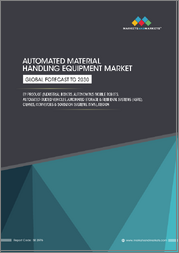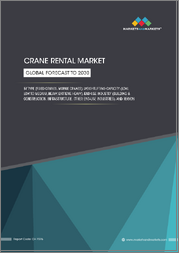
|
시장보고서
상품코드
1499975
세계의 크레인 시장 평가 : 유형별, 용도별, 지역별, 기회, 예측(2017-2031년)Crane Market Assessment, By Type [Mobile Cranes, Fixed Cranes], By Application [Construction and Mining, Marine and Offshore Exploration, Industrial, Others], By Region, Opportunities and Forecast, 2017-2031F |
||||||
세계 크레인 시장 규모는 2023년 385억 1,000만 달러에서 2031년 579억 1,000만 달러에 달할 것으로 예상되며, 2024-2031년 예측 기간 동안 연평균 5.23% 성장할 것으로 예상됩니다. 인프라 개발과 도시화가 진행됨에 따라 시장은 강력한 성장률로 번창하고 있습니다.
세계 인구의 증가는 건설 기계와 건설 자재에 대한 수요를 촉진하고 있습니다. 크레인은 건설, 유지보수 및 탐사 프로그램에서 광범위한 역할을 수행합니다. 텔레매틱스와 같은 현대적 시스템의 도입과 모바일 크레인의 높은 채택률은 시장 확대에 혁명을 일으키고 있습니다. 또한, 인도, 중국 등 신흥 경제국에서 상업 및 주거 공간의 급속한 확장은 시장 성장을 촉진할 것으로 예상됩니다. 과거 오버헤드 크레인은 거대하고 오래 지속되는 구조물로 알려져 있었습니다. 그러나 현대의 기술 혁신과 독창적인 제조 기술은 크레인 기술의 한계를 뛰어넘어 더 작고 가벼운 크레인을 생산하고 있습니다.
경량 크레인은 구조적 부담 감소, 리프팅 능력 향상, 에너지 효율 개선 등 많은 이점을 제공합니다. 오버헤드 크레인 부문은 전 세계적으로 지속가능성에 대한 관심이 높아짐에 따라 에너지 효율이 높은 솔루션에 집중하고 있습니다. 각 제조업체들은 성능과 생산성을 저하시키지 않으면서도 전력 소비를 줄이는 최첨단 기술을 개발했습니다. 최신 오버헤드 크레인에는 첨단 전력 관리 시스템, 회생제동시스템, 가변 주파수 드라이브와 같은 에너지 절약 기술이 탑재되어 있습니다.
예를 들어, 2023년 10월 PACEO Corp.와 MITSUI E&S는 수소연료전지로 구동되는 고무 타이어 갠트리(RTG) 크레인을 로스엔젤레스 항구에 도입했습니다. H2-ZE RTG Transtainer Crane으로 알려진 이 크레인은 2024년 5월 15일 Yusen Terminals Inc.에서 상업 운전을 시작했습니다. 이 크레인은 연료전지 수소 기술로 구동되며, 배기가스 배출이 없는 터미널 운영의 새로운 기준을 제시합니다. 기존 디젤 엔진 크레인과는 달리, 독자적인 기술로 전력망에 의존하지 않고도 무공해화를 달성할 수 있습니다.
인프라 확대와 급속한 도시화로 시장 성장 촉진
정부와 민간 부문의 대규모 프로젝트에 대한 대규모 투자로 인한 급속한 인프라 구축은 건축용 크레인의 필요성을 촉진하고 있습니다. 특히 제3세계 국가에서는 도심의 확장이 그 증가에 박차를 가하고 있습니다. 도심이 확장됨에 따라 더 많은 주택과 사업장이 필요하며, 그 결과 더 많은 개발 작업이 수행되고 건설 기계 소비가 증가할 것이 분명합니다. 제조, 석유 및 가스, 통신 등 여러 산업에서 마케팅에 도움이 되는 우수한 건축물이 필요합니다. 기존의 대안보다 더 나은 성능과 적은 에너지 소비로 인해 이러한 기계는 다양한 산업에서 보편화되고 있습니다. 해양 및 해운 부문의 확장은 예측 기간 동안 시장을 성장시킬 것으로 예상됩니다.
예를 들어, 2023년 12월 APMT(APMT Terminals) Elizabeth로 명명된 Maersk의 운송 및 물류 부문은 새로운 ZPMC Super Post-Panamax Ship-to-Shore(STS) 크레인 두 대를 설치하기 시작했습니다. 이 크레인은 23개의 컨테이너를 적재할 수 있어 네오 파나막스 및 초대형 컨테이너선(ULCV)을 모두 처리할 수 있습니다. 보도에 따르면 이 크레인은 미국 동부 해안에 기항하는 최대 18,000TEU를 적재할 수 있는 대형 선박에 대응할 수 있도록 테스트 및 준비가 완료된 것으로 알려졌습니다.
지속가능한 전기 크레인이 세계 시장 성장의 미래가 될 것
세계 각국 정부는 이산화탄소 배출과 화석연료 소비를 제한하기 위해 노력하고 있습니다. 이에 따라 수소 연료전지 기술과 전기 크레인이 탄생했습니다. 전기 크레인은 배기가스를 배출하지 않기 때문에 대기 오염과 온실 가스 배출을 줄일 수 있습니다. 기존 크레인에 비해 훨씬 조용하고 소음 공해를 줄여 대기 환경을 개선합니다. 또한 현재 배터리의 연속 작동 시간은 8시간으로 에너지 분산을 크게 줄이고 효율을 높입니다. 전기 크레인은 종종 과부하 보호 및 정밀 제어와 같은 고급 안전 기능을 갖추고 있습니다. 이러한 전기 크레인은 현재 더 높은 용량과 생산성을 갖도록 개선되고 있습니다.
이 보고서는 세계 크레인 시장에 대해 조사 분석했으며, 시장 규모와 예측, 시장 역학, 주요 기업 현황과 전망 등을 제공합니다.
목차
제1장 조사 방법
제2장 프로젝트 범위와 정의
제3장 주요 요약
제4장 고객의 소리
- 제품과 시장 정보
- 브랜드 인지 방식
- 구입 결정에서 고려되는 요소
- 프라이버시와 안전 규제 고려
제5장 세계의 크레인 시장 전망(2017-2031년)
- 시장 규모와 예측
- 금액
- 수량
- 유형별
- 이동식 크레인
- 고정식 크레인
- 용도별
- 건설, 광업
- 해사, 오프쇼어 탐사
- 산업
- 기타
- 지역별
- 북미
- 유럽
- 아시아태평양
- 남미
- 중동 및 아프리카
- 시장 점유율 : 기업별(2023년)
제6장 세계의 크레인 시장 전망 : 지역별(2017-2031년)
- 북미
- 시장 규모와 예측
- 유형별
- 용도별
- 미국
- 캐나다
- 멕시코
- 유럽
- 독일
- 프랑스
- 이탈리아
- 영국
- 러시아
- 네덜란드
- 스페인
- 터키
- 폴란드
- 아시아태평양
- 인도
- 중국
- 일본
- 호주
- 베트남
- 한국
- 인도네시아
- 필리핀
- 남미
- 브라질
- 아르헨티나
- 중동 및 아프리카
- 사우디아라비아
- 아랍에미리트
- 남아프리카공화국
제7장 시장 매핑(2023년)
- 유형별
- 용도별
- 지역별
제8장 거시적 환경과 산업 구조
- 수급 분석
- 수입 수출 분석
- 밸류체인 분석
- PESTEL 분석
- Porter's Five Forces 분석
제9장 시장 역학
- 성장 촉진요인
- 성장 억제요인(과제, 제한)
제10장 주요 기업 상황
- 시장 리더 상위 5개사 경쟁 매트릭스
- 시장 리더 상위 5개사 시장 매출 분석(2023년)
- 인수합병/합작투자(해당되는 경우)
- SWOT 분석(시장 기업 5개사)
- 특허 분석(해당되는 경우)
제11장 가격 분석
제12장 사례 연구
제13장 주요 기업 전망
- Sany Group
- Manitowoc Company Inc.
- Tadano Ltd.
- Liebherr Group
- Zoomlion Heavy Industry Science and Technology Co. Ltd.
- Terex Corporation
- Xuzhou Construction Machinery Group Co. Ltd.
- IHI Corporation
- Konecranes Plc
- Cargotec Corporation
- Action Construction Equipment Ltd.
제14장 전략적 추천
제15장 당사 소개와 면책사항
ksm 24.06.28Global crane market is anticipated to witness a CAGR of 5.23% during the forecast period 2024-2031, growing from USD 38.51 billion in 2023 to USD 57.91 billion in 2031. The market thrives at a strong growth rate due to increased infrastructure development and urbanization.
The rising global population is propelling the demand for construction equipment and materials. The cranes play an extensive role in any construction, maintenance, and exploration program. Incorporating modern systems such as telematics and higher adoption of mobile cranes are revolutionizing the market expansion. Furthermore, the rapid expansion of commercial and residential spaces in emerging economies, such as India and China, is expected to garner market growth. In the past, overhead cranes were known for their colossal, long-lasting buildings. However, modern innovations and ingenious manufacturing techniques are pushing the boundaries of crane technology, producing smaller and lightweight cranes.
Lightweight cranes offer many advantages, such as reduced structural strain, increased lifting capability, and improved energy efficiency. The overhead crane sector has strongly focused on energy-efficient solutions in response to the growing global emphasis on sustainability. Manufacturers have created cutting-edge technology to lower power consumption without compromising performance and productivity. Modern overhead cranes have energy-saving technologies such as advanced power management systems, regenerative braking systems, and variable frequency drives.
For instance, in October 2023, PACEO Corp. and MITSUI E&S introduced hydrogen fuel cell-powered rubber-tired gantry (RTG) cranes at the Port of Los Angles. It is known as the H2-ZE RTG Transtainer Crane, which began commercial operations at Yusen Terminals Inc. on May 15, 2024. The Crane is powered by fuel-cell hydrogen technology, setting a new standard for emissions-free terminal operations. Unlike traditional diesel-powered cranes, the unique technology can achieve zero emissions without relying on the electric grid.
Infrastructure Expansion and Rapid Urbanization to Fuel the Market Growth
Rapid infrastructure, with large investments by the government and private sectors in large-scale projects, fuels the requirement for cranes for building purposes. The expansion of towns, especially in third-world nations, adds to its increase. With the expansion of town centers, it is evident that more houses and business premises are required, which certainly results in more development work being carried out, increasing construction equipment consumption. Improved structures are necessary for several industrial verticals, including manufacturing, oil and gas, and telecommunications, which helps with marketing. With better performance and less energy consumption than conventional options, these machines are becoming more common in various verticals. The expanding marine and shipping sector is projected to grow the market during the forecast period.
For instance, in December 2023, Maersk's Transport and Logistics division, named APM Terminals (APMT) Elizabeth, launched the installation of two new ZPMC Super Post-Panamax Ship-to-Shore (STS) cranes. The cranes can handle both Neo-Panamax and ultra-large container vessels (ULCVs) due to their 23-container outreach. According to reports, the cranes are tested and prepared to handle the largest ships, which can hold up to 18,000 TEU, that call on United States east coast ports.
Sustainable and Electric Cranes to Become the Future of Global Market Growth
Governments across the globe are pushing to limit carbon emissions and fossil fuel consumption. Hence, the origin of hydrogen fuel cell technology and electric cranes have come into existence. Electric cranes don't produce exhaust gases, so air pollution and greenhouse gas emissions decrease. Compared to conventional models, they are far quieter, lowering noise pollution and enhancing air quality. Moreover, current batteries have an 8-hour continuous runtime, greatly lowering energy dispersion and boosting efficiency. Electric cranes frequently have sophisticated safety features, including overload protection and precision control. These electric cranes are now being revised to have higher capacity and productivity.
For instance, At Bauma Conexpo 2023, India, ACE - Action Construction Equipment (ACE) Ltd. launched the country's first fully electric mobile crane, its largest domestic mobile crane with a lifting capability of 180 tonnes, and its first self-propelled aerial work platforms. The electric crane is built to give maximum power and productivity while keeping the equipment adaptable to Indian circumstances as a part of the commitment to promote sustainable technologies.
Rapid Urbanization to Fuel Construction Segment's Growth
The construction segment is expected to lead the global crane market share. Cranes are essential for heavy lifting and material handling in construction projects, including residential and commercial structures, highways, bridges, and public transportation systems. Cranes are required in construction projects as they can handle large equipment and materials. Since lifting equipment is used extensively in numerous building activities, the construction industry is the major consumer of cranes. Moreover, the industry is benefiting from increased government initiatives related to infrastructure development. It is anticipated that end-users in the mining, oil and gas, industrial, and other sectors will have gradual market expansion and consistent global investment growth.
For instance, in August 2023, Sany Group launched its first 50-ton electric crane, the STC500BEV, and deployed it to the construction of the Changsha Xianglu Island Bridge Project. The STC500BEV crane's extraordinary silence, in stark contrast to the booming engines of other equipment, is what makes it stand out on the busy construction site.
Asia-Pacific Dominates the Global Crane Market Share
Asia-Pacific, including emerging economies such as China and India, are accelerating the regional market growth rate. These rapidly growing economies constantly indulge in construction, port development, trade, and other economic activities. Infrastructural growth requires a large amount of construction equipment, including cranes. Different types of terrains in these nations add dynamics to the market as varied environments demand specific cranes for lifting.
China's dominant position in the Asian market regarding market share and growth rate can be attributed in large part to the increase in real estate sector investments in residential and commercial infrastructure. The demand for China-based machinery has increased globally because the major Chinese manufacturers, SANY, Zoomlion, and XCMG, are using innovative technologies to carve out niches for themselves in the global market.
India, on the contrary, is deploying big cranes for its major construction projects to accelerate infrastructural growth. For instance, in March 2024, the new Noida International Airport will be built on the outskirts of New Delhi, and it will be led by Tata Projects. The business rented three MCT 385 A tower cranes from rental partners and bought two Potain MCT 565 A topless tower cranes to oversee lifting activities on the massive infrastructural expansion.
Future Market Scenario (2024 - 2031F)
Rapid infrastructural development along with increased maintenance activities are anticipated to fuel the market growth.
The market for cranes in the energy exploration, mining, and trade sectors is likely to grow due to the higher adoption of cranes.
Remote monitoring and control, extended rope life, automation, and integration of IoT are some of the major trends that are projected to shape the market growth trajectory.
The use of lightweight materials, compact designs, and greater customization and adaptability is expected to expand the global crane market.
Key Players Landscape and Outlook
Key participants in the global crane market are focusing on advancing the cranes with the latest technology to increase their capability and efficiency. Furthermore, the usage of lightweight material, compact design, and higher customization and adaptability are some of the elements which key players adopt while building cranes. Alongside, strategic partnerships, collaboration, acquisitions, and product launches are used as the major elements of the market's strategic landscape.
In April 2024, Manitowoc Company Inc. launched two new Potain luffing jib cranes named MR 309 and MR 329. These variants come in 16 t and 25 t maximum capacity variants. Both cranes have a 60 m jib and a 3.4 t capacity at the tip, but because of their differing 2 m and 2.45 m pivot and mast arrangements, they have different load curves and heights under the pivot.
In May 2024, Liebherr Group launched mobile construction cranes in the United States. Three versions with three, four, or five-axle configurations, hook heights up to thirty-nine feet, lifting radiuses exceeding two hundred feet, and different lifting capacities make up the current MK series of mobile construction cranes.
Table of Contents
1. Research Methodology
2. Project Scope and Definitions
3. Executive Summary
4. Voice of Customer
- 4.1. Product and Market Intelligence
- 4.2. Mode of Brand Awareness
- 4.3. Factors Considered in Purchase Decisions
- 4.3.1. Material
- 4.3.2. Design and Mechanical Structure
- 4.3.3. High-Quality Components
- 4.3.4. Operability
- 4.3.5. Safety
- 4.3.6. Functional Performance
- 4.3.7. Third-Party Inspections
- 4.4. Consideration of Privacy and Safety Regulations
5. Global Crane Market Outlook, 2017-2031F
- 5.1. Market Size & Forecast
- 5.1.1. By Value
- 5.1.2. By Volume
- 5.2. By Type
- 5.2.1. Mobile Cranes
- 5.2.1.1. All-terrain Crane
- 5.2.1.2. Rough Terrain Crane
- 5.2.1.3. Crawler Crane
- 5.2.1.4. Floating Crane
- 5.2.1.5. Truck-mounted Crane
- 5.2.1.6. Others
- 5.2.2. Fixed Cranes
- 5.2.2.1. Bridge/Overhead Crane
- 5.2.2.2. Bulk-handling Crane
- 5.2.2.3. Hammerhead Crane
- 5.2.2.4. Stacker Crane
- 5.2.2.5. Others
- 5.2.1. Mobile Cranes
- 5.3. By Application
- 5.3.1. Construction and Mining
- 5.3.2. Marine and Offshore Exploration
- 5.3.3. Industrial
- 5.3.4. Others
- 5.4. By Region
- 5.4.1. North America
- 5.4.2. Europe
- 5.4.3. Asia-Pacific
- 5.4.4. South America
- 5.4.5. Middle East and Africa
- 5.5. By Company Market Share (%), 2023
6. Global Crane Market Outlook, By Region, 2017-2031F
- 6.1. North America*
- 6.1.1. Market Size & Forecast
- 6.1.1.1. By Value
- 6.1.1.2. By Volume
- 6.1.2. By Type
- 6.1.2.1. Mobile Cranes
- 6.1.2.1.1. All-terrain Crane
- 6.1.2.1.2. Rough Terrain Crane
- 6.1.2.1.3. Crawler Crane
- 6.1.2.1.4. Floating Crane
- 6.1.2.1.5. Truck-mounted Crane
- 6.1.2.1.6. Others
- 6.1.2.2. Fixed Cranes
- 6.1.2.2.1. Bridge/Overhead Crane
- 6.1.2.2.2. Bulk-handling Crane
- 6.1.2.2.3. Hammerhead Crane
- 6.1.2.2.4. Stacker Crane
- 6.1.2.2.5. Others
- 6.1.2.1. Mobile Cranes
- 6.1.3. By Application
- 6.1.3.1. Construction and Mining
- 6.1.3.2. Marine and Offshore Exploration
- 6.1.3.3. Industrial
- 6.1.3.4. Others
- 6.1.4. United States*
- 6.1.4.1. Market Size & Forecast
- 6.1.4.1.1. By Value
- 6.1.4.1.2. By Volume
- 6.1.4.2. By Type
- 6.1.4.2.1. Mobile Cranes
- 6.1.4.2.1.1. All-terrain Crane
- 6.1.4.2.1.2. Rough Terrain Crane
- 6.1.4.2.1.3. Crawler Crane
- 6.1.4.2.1.4. Floating Crane
- 6.1.4.2.1.5. Truck-mounted Crane
- 6.1.4.2.1.6. Others
- 6.1.4.2.2. Fixed Cranes
- 6.1.4.2.2.1. Bridge/Overhead Crane
- 6.1.4.2.2.2. Bulk-handling Crane
- 6.1.4.2.2.3. Hammerhead Crane
- 6.1.4.2.2.4. Stacker Crane
- 6.1.4.2.2.5. Others
- 6.1.4.2.1. Mobile Cranes
- 6.1.4.3. By Application
- 6.1.4.3.1. Construction and Mining
- 6.1.4.3.2. Marine and Offshore Exploration
- 6.1.4.3.3. Industrial
- 6.1.4.3.4. Others
- 6.1.4.1. Market Size & Forecast
- 6.1.5. Canada
- 6.1.6. Mexico
- 6.1.1. Market Size & Forecast
All segments will be provided for all regions and countries covered
- 6.2. Europe
- 6.2.1. Germany
- 6.2.2. France
- 6.2.3. Italy
- 6.2.4. United Kingdom
- 6.2.5. Russia
- 6.2.6. Netherlands
- 6.2.7. Spain
- 6.2.8. Turkey
- 6.2.9. Poland
- 6.3. Asia-Pacific
- 6.3.1. India
- 6.3.2. China
- 6.3.3. Japan
- 6.3.4. Australia
- 6.3.5. Vietnam
- 6.3.6. South Korea
- 6.3.7. Indonesia
- 6.3.8. Philippines
- 6.4. South America
- 6.4.1. Brazil
- 6.4.2. Argentina
- 6.5. Middle East and Africa
- 6.5.1. Saudi Arabia
- 6.5.2. UAE
- 6.5.3. South Africa
7. Market Mapping, 2023
- 7.1. By Type
- 7.2. By Application
- 7.3. By Region
8. Macro Environment and Industry Structure
- 8.1. Demand Supply Analysis
- 8.2. Import Export Analysis
- 8.3. Value Chain Analysis
- 8.4. PESTEL Analysis
- 8.4.1. Political Factors
- 8.4.2. Economic System
- 8.4.3. Social Implications
- 8.4.4. Technological Advancements
- 8.4.5. Environmental Impacts
- 8.4.6. Legal Compliances and Regulatory Policies (Statutory Bodies Included)
- 8.5. Porter's Five Forces Analysis
- 8.5.1. Supplier Power
- 8.5.2. Buyer Power
- 8.5.3. Substitution Threat
- 8.5.4. Threat from New Entrants
- 8.5.5. Competitive Rivalry
9. Market Dynamics
- 9.1. Growth Drivers
- 9.2. Growth Inhibitors (Challenges and Restraints)
10. Key Players Landscape
- 10.1. Competition Matrix of Top Five Market Leaders
- 10.2. Market Revenue Analysis of Top Five Market Leaders (By Value, 2023)
- 10.3. Mergers and Acquisitions/Joint Ventures (If Applicable)
- 10.4. SWOT Analysis (For Five Market Players)
- 10.5. Patent Analysis (If Applicable)
11. Pricing Analysis
12. Case Studies
13. Key Players Outlook
- 13.1. Sany Group
- 13.1.1. Company Details
- 13.1.2. Key Management Personnel
- 13.1.3. Products and Services
- 13.1.4. Financials (As reported)
- 13.1.5. Key Market Focus and Geographical Presence
- 13.1.6. Recent Developments
- 13.2. Manitowoc Company Inc.
- 13.3. Tadano Ltd.
- 13.4. Liebherr Group
- 13.5. Zoomlion Heavy Industry Science and Technology Co. Ltd.
- 13.6. Terex Corporation
- 13.7. Xuzhou Construction Machinery Group Co. Ltd.
- 13.8. IHI Corporation
- 13.9. Konecranes Plc
- 13.10. Cargotec Corporation
- 13.11. Action Construction Equipment Ltd.
Companies mentioned above DO NOT hold any order as per market share and can be changed as per information available during research work.



















